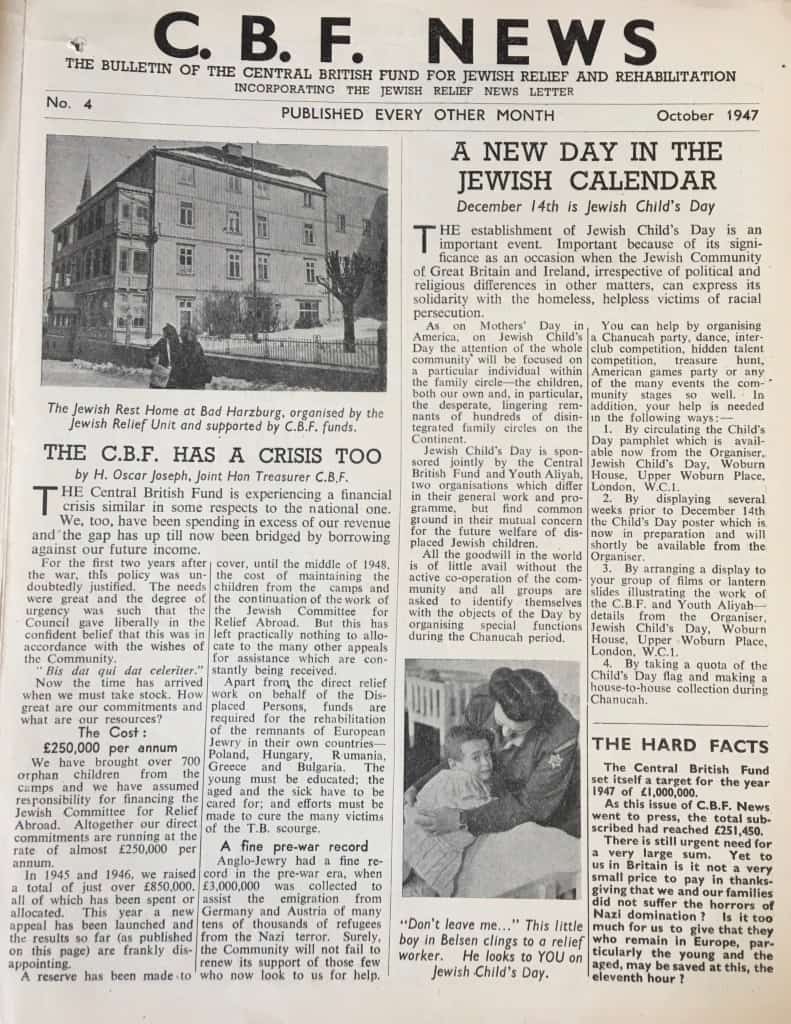TEMPORARY PLACEMENT
THE BOYS’ STORY
From 1942 onwards, reports of the mass murder of Jews in continental Europe began to reach Britain. As the tide of the war turned against Germany and its allies, the British Jewish community started to plan for post-war relief work.
At first it was feared that no children would be found alive but in May 1945, the Central British Fund’s Leonard Montefioretravelled to Paris to meet with the heads of Jewish organisations.
There, Montefiore discovered that some children had indeed survived and he immediately began working on a plan to bring them out of war-torn Europe. Before returning home, he wrote to the CBF’s chairman Anthony de Rothschild outlining a scheme to bring ‘a few hundred children from Bergen-Belsen or Buchenwald’ to Britain.
While in Paris, and later in London the following month, Montefiore met with Joe Schwartz, the European director of the American Joint Jewish Distribution Committee, the JDC. Schwartz was convinced that there was no future for the Jewish people in central and eastern Europe and was keen that the survivors found a new home.
From early 1945 the JDC had been working with survivors in liberated eastern Czechoslovakia and Schwartz knew that a large number of children and young people had survived in the Theresienstadt ghetto and was looking for a way to get them to safety. The partnership between Montefiore and Schwartz was the first step in what was to become the remarkable story of the Boys.
FINDING THE CHILDREN
To administer the scheme the CBF set up a sub-committee, the Committee for the Care of the Concentration Camp Children.
A plan to bring 1,000 children to the UK was one thing, but locating and organising an airlift out of Europe was quite another.
In Germany, the initial policy of the Allied-occupying powers was that all child survivors should be moved out of the country but, in the weeks after the liberation, the United Nations Relief and Rehabilitation Administration (UNRRA), the organisation responsible for the care of refugees, felt that it was against the rights of the child to send them to other countries.
UNRRA staff also saw that the children had developed relationships with aid workers and other child survivors, which were vital for children who were the sole survivors of their families and thus they were hesitant to break such bonds.
There was also the question of where these children themselves wanted to go.
After the end of the war, survivors who were placed in displaced persons’ camps were asked to register where they would like to be resettled. The overwhelming majority of the children, who were to become the Boys, said they wanted to go to Palestine, as did many Jewish survivors.
The British, who were in control of Palestine at this point, had put in place severe restrictions on the number of Jews allowed to settle there in the 1939 White Paper and these remained in place after the war. Many of the Boys said that, when offered the possibility of going to Britain, theychose to come, as it seemed an option that would eventually take them to Palestine.
FOUR GROUPS
The Boys arrived in four groups.
The first grouparrived in August 1945 and the second groupin October 1945. A group, who should have been taken to a hostel inHemel Hampstead, were blocked from leaving Germany in November 1945.
The third group arrived in the UK in March 1946 and the fourth groupin June 1946.
MONTEFIORE MAKES A STAND
The economic situation in Britain after the Second World War was extremely difficult and the CBF found raising money a challenge.
As a result, although the British government had offered visas for 1,000 children, the CBF could only finance just over 700 child Holocaust survivors.
Despite their financial difficulties, in May 1946, the CBF turned down an offer of assistance from the Peace Pledge Union and the Quakers because Montefiore firmly believed that the child Holocaust survivors needed to be cared for in a Jewish environment.
Montefiore’s commitment was to the children in his care and he made his views clear in the chairman’s report discussed at the committee meeting on 3 June 1946. In the report Montefiore said that if the CBF committed itself to ‘mass immigration’ and the housing of children in large units, that he would resign.
Montefiore believed it was more important to care for the Boys already in the UK properly than provide inadequate care for hundreds more.
A month later on 4 July 1946, the Kielce pogrom in Poland would kick off a major refugee crisis as thousands of Jewish survivors, among them hundreds of orphans, flooded out of Poland intent on finding a new home in Palestine. That same month, the British decided that they had no choice but to intern in Cyprus those trying to enter the Mandate territory illegally. Hundreds of orphans spent months in terrible conditions on the island.
The minutes of subsequent meetings of the Committee for the Care of the Concentration Camp Children show there was no further discussion of bringing any more children to Britain, and the committee’s Ruth Fellner moved from working on immigration to plans for the Boys’ emigration as their two year visas were rapidly running out.
